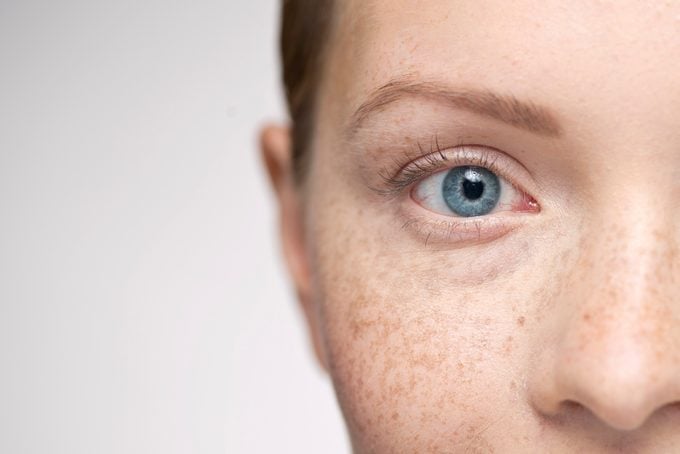What Is a Cataract? These Are the Causes, Symptoms, and Treatments of Cataracts
Updated: Apr. 29, 2021
Think you may have a cataract? There's plenty you can do. From causes to symptoms to treatments, here's what you need to know about this common eye condition, which is caused by a clouding of the normally clear lens of the eye.
Cataracts are like death and (yup) taxes: Inevitable. At some point—usually as you enter middle age—most people develop this eye condition, which is a clouding of the eye’s lens that can get progressively worse and impair your vision.
But don’t worry. Unlike death and taxes, there’s plenty you can do about them. Here’s what you need to know about the symptoms, risks, causes, and treatments for cataracts.
What are cataracts?
Imagine you’re trying to snap a picture, but the lens of your camera has been smeared with Vaseline. You can still see through it, but it’s blurry, out of focus, cloudy. That’s what it’s like when you have cataracts. According to the American Academy of Ophthalmology (AAO), about 25 million Americans have them and they’re the leading cause of blindness worldwide (mostly because of limited access to treatment in developing countries).
Cataracts are diagnosed through a simple eye exam that includes dilation (your pupils are widened with the help of eye drops) so that your eye doctor can thoroughly examine your eyes, looking for abnormalities in your cornea, iris, lens, and other areas at the front of your eyes; and specific signs of cataract at the back of your eyes.
There are five types of cataracts:
- Age-related cataract: By far the most common, this occurs as you get older. Over time, natural changes in the lens of your eye cause the tissue within the lens of each eye to break down and clump together, creating cloudy areas that affect vision.
- Traumatic cataract: As the name suggests, this occurs after an eye injury that affects the lens. Sometimes the cataract forms quickly; other times, it’s many years later. Up to one in five adults—especially men and young adults—will have what’s known as ocular trauma at some point in their lives.
- Radiation cataract: This can be caused by the sun’s ultraviolet (UV) rays or as a result of radiation to treat cancer.
- Pediatric cataract: Children can be born with cataracts or develop them after birth. Unlike cataracts in adults, which happen after the eyes and vision are fully developed, pediatric cataracts can have serious long-term effects on a child’s vision. That’s because a child’s eyes are still developing until around age 9. Without treatment, pediatric cataracts can cause connections between the brain and eye that aren’t normal. Once those are made, they’re permanent.
- Secondary cataract: What’s also known as an “after-cataract” isn’t technically a cataract because it’s caused by cloudiness on the outside of your lens, not the inside, but the vision problems they cause are very similar. As many as half of all people who’ve undergone cataract surgery will develop a secondary cataract months or years later. If so, your ophthalmologist can use a laser to open the cloudy capsule and restore clear vision. This procedure is called a posterior capsulotomy.
 Cataract symptoms
Cataract symptoms
You can get cataracts in one eye or both eyes—but they can’t spread from one eye to the other. In the beginning, you might not have any cataract symptoms. In particular, you won’t experience pain—cataracts are painless. But as cataracts grow, you’ll begin to notice changes in your vision, including:
- Blurry vision
- Seeing double (or diplopia)
- Sensitivity to light
- Trouble seeing well at night, or needing additional light for reading
- Colors looking faded or yellowish
- Vision loss
- Frequent changes in your eyeglass or contact lens Rx
Cataract causes
Inside each of your eyes, you have a lens that’s made up mostly of water and proteins. Normally, the proteins are arranged so that the lens is completely clear, making it easy for light to pass through and allow you to see things clearly. But as a cataract forms, those proteins start to clump together. Over time, those clumps become bigger and thicker, and the lens gradually becomes cloudy.
It may also develop a yellow or brown tint, affecting the way you see colors. The changes to your vision are so slow to develop that you may not even detect a difference in the beginning. Age-related cataracts usually start to form around age 40, but many adults don’t notice the cloudiness in their vision until age 60; for some people, it’s even later.
Eventually, though, what used to be clear becomes hazy or less colorful, the way things look on a foggy day. As a result, you may have difficulty reading, seeing in poorly lit areas, or driving at night.
Sound scary? Cataracts are actually extremely common. More than half of adults over the age of 80 either have cataracts or have had surgery to get rid of cataracts. That’s right: You don’t have to live with them.
Cataract risk factors
Age is the most common cause of cataracts. Having a family history of cataracts raises your risk for getting them, too. Other risk factors include:
Lifestyle-related risk factors:
- Smoking
- Drinking alcohol in excess
- Spending too much time in the sun , especially without sunglasses that protect your eyes from damaging ultraviolet (UV) rays.
Health problem- and medical treatment-related risk factors:
- Diabetes. The main culprit: out-of-control blood sugar
- A serious eye injury or eye surgery
- Taking corticosteroids (inflammation-fighting medicines used to treat a variety conditions including arthritis, asthma, and allergies)
- Getting radiation treatment for cancer or other diseases

Cataract treatments
Whatever the cause of your cataracts, surgery is the only way to get rid of them. There’s no medicine to make them go away. If your symptoms aren’t interfering with your lifestyle, you may opt to simply make tweaks to your lifestyle—for instance, avoid nighttime driving, get a new eyeglass prescription to help you see better, up the amount of greens in your diet—and skip or delay surgery altogether.
If cataracts are coming between you and the things you need and want to do, however, your doctor will most likely recommend surgery. According to the AAO, nearly 4 million people in the United States undergo cataract surgery every year to restore their vision. About nine out of 10 see better afterward. Here’s what to expect:
Before surgery: The procedure involves replacing your natural, cloudy lens with a clear, artificial one known as an intraocular lens (or IOL). Your ophthalmologist will measure your eye beforehand to determine the appropriate prescription for your IOL.
Like your eye’s natural lens, an IOL focuses light that comes into the eye through the cornea and pupil onto the retina, the sensitive tissue at the back of the eye that passes along images to the brain. Most IOLs are made of a flexible, foldable material and they’re tiny (about one-third the size of a dime). Your doctor may prescribe eye drops to use before surgery to help prevent infection and reduce swelling.
During surgery: The procedure is done on an outpatient basis, and you’ll be awake during the procedure (yes, really!). But don’t worry: You won’t see what’s actually happening, your eye will be numbed, and you’ll be given something to help you relax. During surgery, your ophthalmologist will use a laser or a blade to create tiny incisions near the edge of your cornea, creating a sort of thruway to get to the lens in your eye.
The old lens is then broken up and removed, then replaced with the new IOL implant. Start to finish, the procedure usually happens in less than an hour. When you leave your doctor’s office, you’ll likely have a shield over your eye to protect it while you heal from surgery.
After surgery: Your eye may feel a little itchy and sensitive to light initially, but that usually resolves itself after a day or two. Recovery takes about eight weeks. During that period, you’ll wear a shield or eyeglasses to protect your eye when you sleep and possibly during waking hours, too. Following surgery for pediatric cataracts, children often need some combination of contact lenses, glasses, and—if there’s a diagnosis of lazy eye—patching. Ongoing treatment is usually required to teach the eyes how to focus properly.
The science of cataracts
Cataract surgery is not only one of the most common procedures performed worldwide, it’s also considered among the most successful. So why tinker with success? Here’s why: Scientists are still looking to discover a way to prevent cataracts in the first place, and at the very least slow their progression and improve the existing surgical approaches to treating the condition.
Take, for instance, intraocular lenses (IOLs). Despite the availability and variety of these artificial lenses, not all implants are suitable for every patient. One development on the horizon is what’s known as adjustable lens technology, in which the power of the implanted lens can be adjusted after surgery with a secondary procedure. The goal? A higher level of precision in cataract surgery.
In an effort to understand the cause of cataracts—beyond the normal wear-and-tear of aging, smoking, and exposure to UV rays, all of which can damage a lens’ fiber cells—researchers are studying the role that genes play. So far, they’ve discovered 37 genes associated with congenital cataracts (those that result as a developmental defect).
Understanding the genetics of cataracts can shed light on how the lens itself works, and who might be at higher risk for cataracts. Although congenital cataracts are relatively rare, studying them may help scientists better understand how the more common age-related cataracts develop.
Another area ripe for improvement: How to reduce the incidence of secondary cataracts. Scientists have known for a while that cataracts occur when the cells of the lens lose their transparency. During cataract surgery, the aim is to remove as many of those cells as possible, but not even the best surgeon can remove all of them.
As a result, almost 50 percent of patients end up developing cells at the back of their artificial lenses five to 10 years after they’ve had surgery. These new cells lack transparency, causing what’s known as posterior capsular opacification, or secondary cataract.
Although it can be treated by laser surgery, the procedure can cause problems with the artificial lens or in rare cases the retina. Researchers are investigating how to prevent these “after cataracts,” as they’re also known, from happening in the first place.
A review of studies published in 2020 in Anatomical Record suggests part of the solution may be in understanding how post-surgery wound repair leads to what’s known as fibrosis, which causes haze and scarring in the lens. Stopping the injury response may keep the lens clear.
Personal stories
Plenty of people have triumphed over cataracts. See how they did it.
- Too young for cataracts—or was I?
- What Doctors Don’t Tell You About Cataract Surgery
- Why More Boomers are Getting Cataract Surgery at a Younger Age
- What People Cured of Blindness See
- Cheryl Ladd Feels Young and Optimistic at 68 — Here’s Why
- Free from cataracts, and back at school!
Helpful products
Just because cataracts are inevitable doesn’t mean you’re powerless to slow down the progression of the disease. Much of it comes down to protecting your eyes from sunlight and making small tweaks to your diet.
- The Best Sunglasses for UV Protection
- The Best Polarized Sunglasses, According to Optometrists
- 7 Foods That May Improve Your Eyesight
- The Best Sunglasses for Your Face Shape
Additional resources
If you need additional help with cataracts, where do you go next? Here are some trusted sources that may help.



